Matt Rees's Blog - Posts Tagged "rome"
On Caravaggio’s Trail: Travelling to Research A NAME IN BLOOD
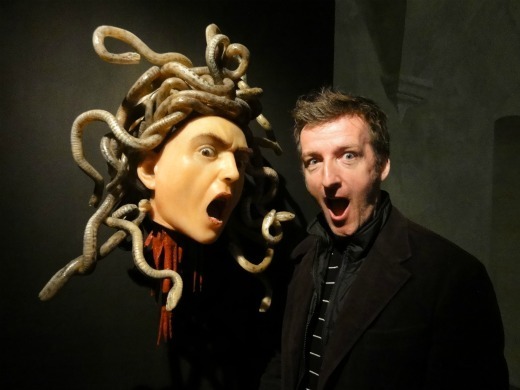
As I researched A Name in Blood, my novel of Caravaggio, I went all over Europe and North America, tracking Caravaggio's works and the places that touched his life. The period locations I visited gave me a flavour for Caravaggio’s life. In some cases, they gave me ideas for plot twists in the book.
Everywhere I found people fascinated with this most compelling of artists. On one of my sojourns in Rome, there was an exhibition devoted to Caravaggio's use of mirrors to project images (over which he painted, giving the vivid realistic feel people usually notice when they first see his work). He used his own head, probably in a convex mirror, to paint his "Medusa," which ended up in Florence at the Galleria Uffizi. The Rome exhibit made a nice mock up. Life size, as you see, though perhaps not as scary as a traveling author making a funny face.
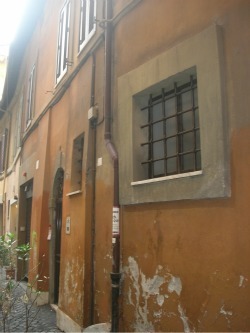
Caravaggio lived most of his time in Rome in the palaces of wealthy patrons. For a brief period, he rented this house (right) in a tiny street in Rome's historic center. Then he fell behind on the rent, lost the place, got drunk and went around to break his landlady's windows. I stood in the tiny alley imagining what it must have been like to be Madama Bruni, with a raging nutcase hurling rocks at her shutters from a yard away and bellowing that he was going to carve her up. Unfortunately I had to cut that incident out of A Name in Blood because, as with some other juicy moments in Caravaggio’s life, they were deeply revealing, but they didn’t drive my narrative forward.
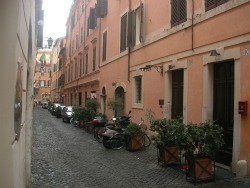
Caravaggio’s model (and, I think, lover) Lena lived here (left). In the Via dei Greci. In the heart of what used to be the Ortaccio, or Evil Garden, where only whores and the very poor lived. And artists, of course. Both places are now very expensive spots in the middle of Rome’s tourist area. But they're still redolent of C's time. At night, they're dark and empty. Though not spooky. I never get spooked in Rome. I’m too damned happy there.
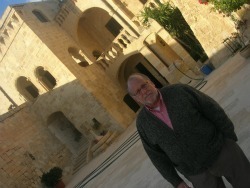
Rome was an important stop on my researches into period locations (as opposed to my more farflung journeys to the many galleries housing Caravaggio’s work), but Malta was in many ways the most compelling, because Caravaggio’s influence is still so considerable. Caravaggio is an important figure for its capital, Valletta, where he became a Knight of Malta and painted one of his masterpieces, The Beheading of Saint John for the city’s cathedral. Father John Critien (right) is the only Knight of Malta who currently lives in Castle Sant'Angelo on Valletta's harbor. C was imprisoned here, and made a dramatic escape. Father John and I spent a delightful afternoon examining all the spots where Caravaggio might've been held. Many think it was in a hole in the rock called the guva.
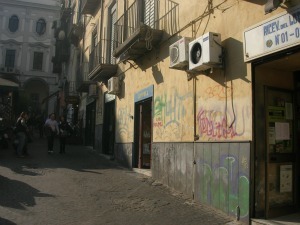
On to Naples I went. At left is the site of the Ceriglio Tavern, where Caravaggio was attacked on his way out. He got a scar, probably just to teach him a lesson rather than an attempt to kill him, and an injury to his eye, which can be seen in his last work, David with the Head of Goliath. I noticed that for much of the afternoon anyone leaving the Ceriglio and headed toward Caravaggio's digs at what’s now called the Palazzo Cellamare would be blinded by the sunlight. A good time for an attack.
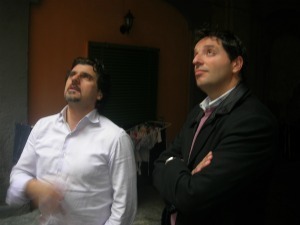
My friend Ugo Somma, far right, showed me around Naples. Here he is examining the chapel of the Knights with a fellow named Rosario who works for the Knights of Malta in Naples. At first Rosario wouldn't let us look around the Knights' church. But when I told him he looked like Caravaggio, he relented and even introduced me to his sister...
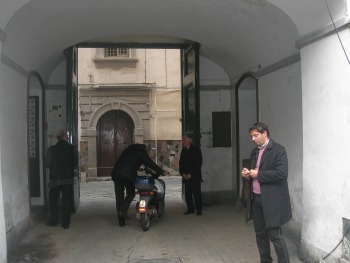
At the Knights' Priory in Naples, these fellows were hanging around in the courtyard looking like mafia capos waiting to rub someone out. A non-Neapolitan had been named that morning as the new Prior. They were, as the Italians say, "arrabiati." Mad as hell. Their sullen expressions and taciturn demeanor gave me an idea for a plot twist in A Name in Blood….
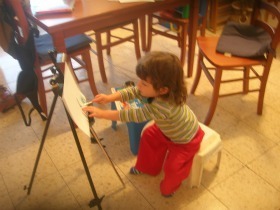
My son became an aficionado of Caravaggio as the research went on. He visited many of the galleries and churches in Rome where Caravaggio’s paintings hang. When I was painting my own versions of Caravaggio’s Madonnas, I told him the woman was named Mary. He decided we had to call his new sister by that name, which we did (in the Welsh fashion, it’s spelled Mari.) His name being Cai, we dubbed him Cairavaggio.
One of my earliest memories is of a schoolteacher who had been in Naples with the British army in World War II. He wasn’t talkative, but one day he told me about a hunchback who had beckoned him to a garden and shown him the most beautiful sight he had ever seen: the perfect view over the Bay of Naples. Somehow that simple recollection of beauty by an old man, unfolded in an uncomplicated way to a small boy, brings tears to my eyes. I found the same beauty in Naples—alongside considerable depravity, too. They say, "See Naples and die." Unfortunately for Caravaggio, that's how it worked out, quite literally. Naples is magical, lively, putrid and beautiful. From the Spanish Palace looking at San Francesco, here's one moment when I thought: Matt, you lucky fellow, isn't "research" great?
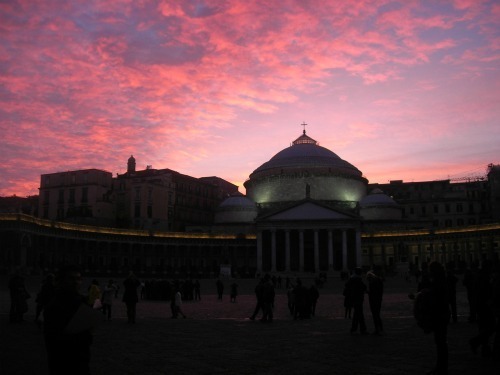
Published on June 06, 2012 04:10
•
Tags:
a-name-in-blood, art, art-history, caravaggio, crime-fiction, historical-fiction, malta, naples, rome
Too Many Drugs: Following Caravaggio in Malta for A NAME IN BLOOD
 I left Rome to continue my research for A Name in Blood, my Caravaggio novel which is released July 1 in the UK, in Malta. Caravaggio fled to the remote island off the coast of Africa and became (briefly) a member of the Knights of Malta. It was a strange trip for me, but the isolation and pure weirdness I felt there gave me important insights for the novel.
I left Rome to continue my research for A Name in Blood, my Caravaggio novel which is released July 1 in the UK, in Malta. Caravaggio fled to the remote island off the coast of Africa and became (briefly) a member of the Knights of Malta. It was a strange trip for me, but the isolation and pure weirdness I felt there gave me important insights for the novel.I spent December in Malta in a cheap hotel in a four-hundred-year-old building that was without heating and insulation, in a room where one of the windows didn’t close. I got sick. I took some drugs, staring across the harbor at the sheets of rain plummeting down on the Castel Sant’Angelo where Caravaggio was imprisoned for a time. It got damper in my room. I took too many drugs. I hallucinated, slept at unaccustomed hours and was awake when everyone else was in bed. I saw things that weren’t there. I drank far too many espressos at the Café Merisi, which takes Caravaggio’s family name and emblazons his face on the napkins, until I was as jittery as a June bug. A June bug with an overdose.
In this condition, I stood all day before The Beheading of Saint John, Caravaggio’s largest canvas and one of his most gruesome and disturbing. He showed John the Baptist collapsing, hands bound, on the floor of a dungeon, his executioner sawing his head away and a jailor gesturing for the severed head to be placed on a platter held by a young woman. It’s the only painting where Caravaggio signed his name. And he did it in a deep red, mingling with the blood spurting from the dying saint’s neck, giving me the title of my novel: A Name in Blood.
At night I wandered the narrow, deserted, windswept streets of Valletta’s Baroque center, weaving light-headed over the flagstones under the sad Christmas lights that rocked on the wind. Loudspeakers on the street lamps played cheesy carols. Alone as I was, I sang along, laughing to myself and feeling more than a little unhinged. In the alleys, I imagined Caravaggio here, knowing that men sought to kill him. I jogged giggling up the banks of steps that connect the streets along Valletta’s high ridges, as if I were fleeing. I panted in fear and slugged down some more drugs from the pocket of my raincoat and felt his horror of the dark.
I knew why Caravaggio had painted his figures emerging from the threatening shadows into a light so luminous that it glows straight through your skin and eyes and into the seat of your capacity for love, wherever that may be.
Stumbling down the steps toward my hotel above the gate where the Knights used to display the heads of Muslim pirates on spikes, I knew I was ready to write.
Published on June 07, 2012 01:15
•
Tags:
a-name-in-blood, art, art-history, caravaggio, crime-fiction, historical-fiction, malta, naples, research, rome
5 Places to Eat in Rome You Mustn't Miss
 I've spent a lot of time in Rome over the years, including an extended period to research my novel about the great artist Caravaggio, A Name in Blood. Even a writer's got to eat, so here are the unmissable eateries of the eternal city.
I've spent a lot of time in Rome over the years, including an extended period to research my novel about the great artist Caravaggio, A Name in Blood. Even a writer's got to eat, so here are the unmissable eateries of the eternal city.1. Sora Margherita. Piazza delle Cinque Scole. Looks like a scene from Fellini's Roma, with rough decor, unrestrained atmosphere, and a focus on good food rather than "fine dining." Order anything, it's great. And don't leave food on your plate. The waitress will make you finish it.
2. San Crispino, Piazza della Maddalena and Via della Panneteria. Ice-cream is usually displayed in Rome in massive piles that are supposed to make it irresistible. At San Crispino, they keep the ice-cream under silver covers. But the taste truly is impossible to resist. The house flavor is honey, but the selection is always different. One day there'll be whisky, the next you'll find licorice. I've heard people complain that it's expensive. But as Martin Cruz Smith once said, "You don't sell a ride on a rocket shit for a dollar."
3. Il Fornaio. Via dei Baullari. Near Campo de'Fiori, this bakery/deli has excellent pizza and savories. But if you'd like a sugar-high that won't give you a gelato head-freeze, this is the place. The torta con ricotta e ciocollata is officially designated "the best thing in the world" by my five-year-old son.
4. Obika Mozzarella Bar. Campo de'Fiori, and Piazza Firenze. A chain that has expanded into the UK and USA. But there's nowhere to enjoy it that's better than Rome. A tasting menu of several different mozzarellas comes with a lesson from the staff about what makes a good mozzarella. (If you press it and thin white liquid comes out, it's fresh; if not, blaaah.) Also a great place for morning espresso and pastry.
5. Osteria della Quercia. Piazza della Quercia. In a tiny piazza opposite the Renaissance palazzo where the Council of State sits, in the shade of the oak tree from which it takes its name. A great place for traditional Roman food like deep fried cod and artichokes.
Published on June 18, 2013 01:36
•
Tags:
caravaggio, crime-fiction, food, historical-fiction, italy, rome
The Caravaggio masterpieces that make up the cover of historical novel
The cover of my Caravaggio novel, A Name in Blood, out now in UK paperback, is a composite of two works by the great Italian master....
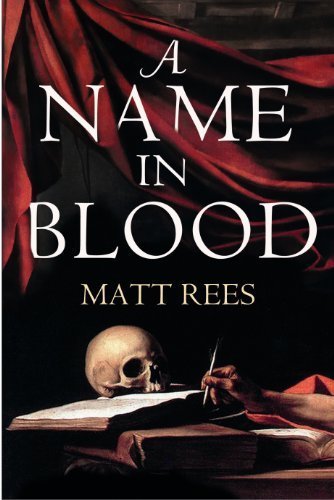
...There's the skull from St. Jerome Writing, painted in 1606 in Rome and still housed in that city at the Galleria Borghese...
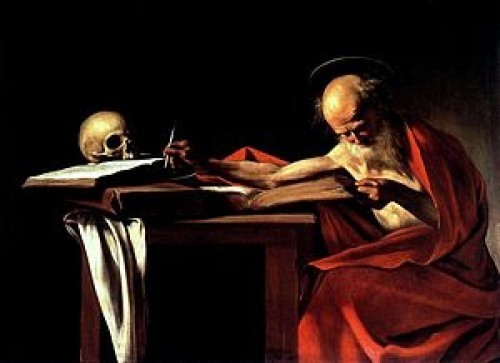
...and, completed in the same year but with distrous results for Caravaggio's career and mental health, The Death of the Virgin. Now in the Louvre, my novel's cover includes the luxurious canopy above the otherwise humble bed of Mary. It was a scandalous piece at the time. Usually the Virgin was portrayed ascending to Heaven. Here she's dying like any peasant woman.
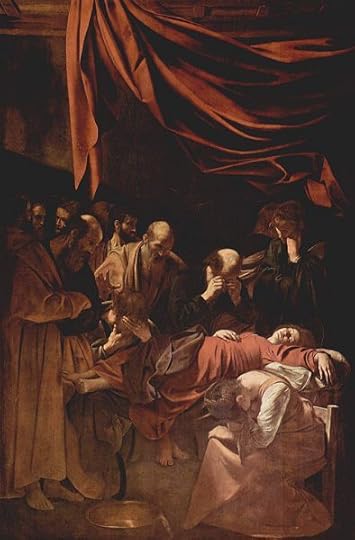

...There's the skull from St. Jerome Writing, painted in 1606 in Rome and still housed in that city at the Galleria Borghese...

...and, completed in the same year but with distrous results for Caravaggio's career and mental health, The Death of the Virgin. Now in the Louvre, my novel's cover includes the luxurious canopy above the otherwise humble bed of Mary. It was a scandalous piece at the time. Usually the Virgin was portrayed ascending to Heaven. Here she's dying like any peasant woman.

Published on June 22, 2013 05:38
•
Tags:
caravaggio, covers, crime-fiction, food, historical-fiction, italy, rome
Daily Caravaggio: Love Victorious
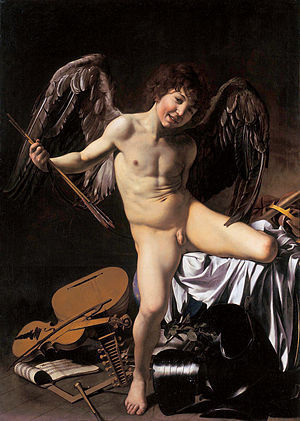 To mark the paperback publication of my Caravaggio novel A NAME IN BLOOD, I'm posting each of the paintings that appear in the book each day for the next month. In the novel I called this one "Love Victorious." (It's often known as "Amor Vincit Omnia.") Caravaggio painted it for Marchese Giustiniani. Onorio, Caravaggio's friend in the novel, calls it "the little Cupid smiling like he was game for anything." That appears to have been what Giustiniani thought too. When he showed visitors around his palazzo, he'd take them to this painting last, pull a cord to draw the curtain, and watch them gasp in shock and titilation. Is there an emoticon for that?...
To mark the paperback publication of my Caravaggio novel A NAME IN BLOOD, I'm posting each of the paintings that appear in the book each day for the next month. In the novel I called this one "Love Victorious." (It's often known as "Amor Vincit Omnia.") Caravaggio painted it for Marchese Giustiniani. Onorio, Caravaggio's friend in the novel, calls it "the little Cupid smiling like he was game for anything." That appears to have been what Giustiniani thought too. When he showed visitors around his palazzo, he'd take them to this painting last, pull a cord to draw the curtain, and watch them gasp in shock and titilation. Is there an emoticon for that?...
Published on August 08, 2013 03:17
•
Tags:
caravaggio, covers, crime-fiction, food, historical-fiction, italy, rome
Daily Caravaggio: Pope Paul V
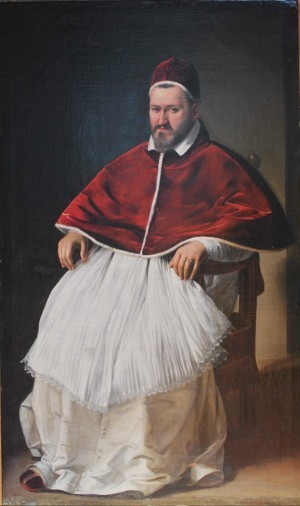 To coincide with the paperback publication of my Caravaggio novel A NAME IN BLOOD, I'm posting each of the paintings that appear in the book each day for the next month. Here's a nasty looking fellow, Pope Paul V. The Borghese Pope was new to the job when he chose Caravaggio to paint his portrait, and it's truly masterly. It doesn't back away from any of the bitterness and mendacity in his face. It reminds me, of course, of Pope Innocent X's reaction to the portrait Velazquez did of him half a century later: "It's too real," he said. By which he meant that the portrait, part of the Doria Pamphilij collection, didn't disguise his deviousness and anger as he might've expected. Here's what the pope's nephew Scipione says to Caravaggio about the portrait in my novel: "One gets the impression that he'll soon deliver some withering reproach." The portrait is privately held in the Palazzo Borghese in Rome. I've had the privilege to stand before it, and it's still more amazing as a life-size composition.
To coincide with the paperback publication of my Caravaggio novel A NAME IN BLOOD, I'm posting each of the paintings that appear in the book each day for the next month. Here's a nasty looking fellow, Pope Paul V. The Borghese Pope was new to the job when he chose Caravaggio to paint his portrait, and it's truly masterly. It doesn't back away from any of the bitterness and mendacity in his face. It reminds me, of course, of Pope Innocent X's reaction to the portrait Velazquez did of him half a century later: "It's too real," he said. By which he meant that the portrait, part of the Doria Pamphilij collection, didn't disguise his deviousness and anger as he might've expected. Here's what the pope's nephew Scipione says to Caravaggio about the portrait in my novel: "One gets the impression that he'll soon deliver some withering reproach." The portrait is privately held in the Palazzo Borghese in Rome. I've had the privilege to stand before it, and it's still more amazing as a life-size composition.
Published on August 09, 2013 01:17
•
Tags:
art-history, caravaggio, covers, crime-fiction, food, historical-fiction, italy, rome
Daily Caravaggio: Madonna of Loreto
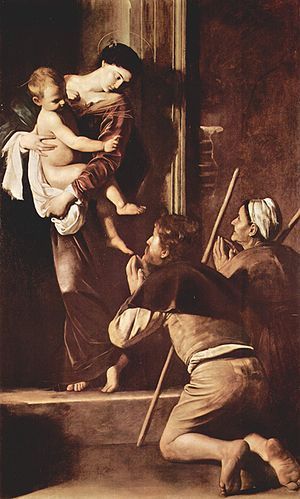 To coincide with the paperback publication of my Caravaggio novel A NAME IN BLOOD, I'm posting each of the paintings that appear in the book each day for the next month. At the center of the novel is Caravaggio's relationship with his model for this painting The Madonna of Loreto, which is in the Church of Sant'Agostino in Rome. Her name was Lena. Caravaggio's portrayals of her, as a Virgin who was also a poor woman living in a slum, were controversial -- even dangerous. Here he sees her at her door for the first time:
To coincide with the paperback publication of my Caravaggio novel A NAME IN BLOOD, I'm posting each of the paintings that appear in the book each day for the next month. At the center of the novel is Caravaggio's relationship with his model for this painting The Madonna of Loreto, which is in the Church of Sant'Agostino in Rome. Her name was Lena. Caravaggio's portrayals of her, as a Virgin who was also a poor woman living in a slum, were controversial -- even dangerous. Here he sees her at her door for the first time:At the burnt sienna towers of the Church of Sant’Atanasio, he cut onto the Via dei Greci, into the Evil Garden. The low morning sun struggled to drive the night from the narrow street. A pair of beggars knelt at the rough gray step of a small house, their fingers steepled, beseeching charity. The young woman in the doorway held a three-year-old boy on her hip. The boy was naked, half wrapped in a towel, as though the beggars’ call had interrupted his bathtime.
Caravaggio approached, watching the girl. The house was dark behind her. Daylight seemed to penetrate the street just for her, illuminating the eggshell clarity of her neck and chest. She crossed her bare feet and went up and down on her toes, pivoting from her hip to swing the boy as she listened to the old woman’s story. She let her head drop to her left so that her chin touched her collar bone, as she looked down upon the kneeling woman with compassion and reassurance.
He recognized her. The maid who had been cleaning the floor at del Monte’s palace. She’s turning her hips the opposite way to her shoulders, he noted, as though she knows about the contrapposto pose. She has found the grace of classical form without anyone having to teach her an academic term for it.
Caravaggio leaned against the wall by the threshold. The plaster had come away beside the chipped travertine of the doorway, exposing the brick beneath. He smiled and was surprised by how little calculation there was in his open look.
Published on August 11, 2013 02:28
•
Tags:
art-history, caravaggio, covers, crime-fiction, food, historical-fiction, italy, rome
Daily Caravaggio: Rest on the Flight into Egypt
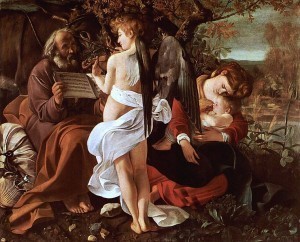 To coincide with the paperback publication of my Caravaggio novel A NAME IN BLOOD, I'm posting each of the paintings that appear in the book each day this month. The Rest on the Flight into Egypt is one of three Caravaggio masterpieces housed at the fabulous Doria Pamphilij Gallery in Rome. It's from about 1597 and is quite unlike his more characteristic later works. But it makes a great impression for the deeply human way in which he portrays relationship between the Virgin and her son. Here's Caravaggio recalling his work on the painting in my novel:
To coincide with the paperback publication of my Caravaggio novel A NAME IN BLOOD, I'm posting each of the paintings that appear in the book each day this month. The Rest on the Flight into Egypt is one of three Caravaggio masterpieces housed at the fabulous Doria Pamphilij Gallery in Rome. It's from about 1597 and is quite unlike his more characteristic later works. But it makes a great impression for the deeply human way in which he portrays relationship between the Virgin and her son. Here's Caravaggio recalling his work on the painting in my novel:
He barely knew what he had done at the time, a few years after arriving in Rome. A scene of the Holy Family succoured by the music of an angel as they fled the vengeful Herod, painted with the dreamy clarity of the Venetian school. But later, in the gallery of the Lady Olimpia Aldobrandini, he had recognized that his heart was imprinted on the canvas.
In that painting, exhausted by the journey, the Holy Mother rested her cheek on her baby’s head. The little Jesus, also half-asleep, picked at her mantle, as though he dreamed of feeding at her breast. Menica’s friend Anna had modelled for the Virgin. She had understood that her life as a cheap whore wouldn’t be a long one. Still she had faith that there might be an escape. Caravaggio had illustrated her hope and fear and acceptance in the drained, loving Virgin. The love of a mother who knew her son would be a sacrifice and was yet willing to undergo the hardships of the desert to preserve him for it. I saw all that in the face of a whore.
Anna had been dead a year now, at twenty-five, her skin wasted and scarred, her red hair dry and lustreless. He was with her at the end, and she had reminisced about the sixteen-year-old beauty he had painted as the Virgin. When she expired, he had dropped his head to her breast and shocked himself with his weeping. He had known many whores who had disappeared from the streets with little more than a shrug from him. Yet he had cried for Anna as though she had invented death, a malignant novelty displayed in a gallery which only he might view.
Published on August 12, 2013 01:43
•
Tags:
art-history, caravaggio, covers, crime-fiction, food, historical-fiction, italy, rome
Read a free chapter from my Caravaggio novel
A chapter from my Caravaggio novel A NAME IN BLOOD about one of the great Italian artist's most famous and controversial works.
 To coincide with the paperback publication of my Caravaggio novel A NAME IN BLOOD, I'm posting each of the paintings that appear in the book each day this month. The Death of the Virgin is truly one of the most magnificent works of art ever painted. These days it's at the Musee du Louvre. But when Caravaggio first revealed it in a Roman church, it caused a scandal and was soon removed. The controversy was caused by the portrayal of the Virgin as a peasant (with a whore used as the model) and as truly dead. Not ascending to heaven. Just dead. Here's one of the chapters from my novel where this painting is central. Caravaggio is summoned to the office of Cardinal del Monte, one of his patrons:
To coincide with the paperback publication of my Caravaggio novel A NAME IN BLOOD, I'm posting each of the paintings that appear in the book each day this month. The Death of the Virgin is truly one of the most magnificent works of art ever painted. These days it's at the Musee du Louvre. But when Caravaggio first revealed it in a Roman church, it caused a scandal and was soon removed. The controversy was caused by the portrayal of the Virgin as a peasant (with a whore used as the model) and as truly dead. Not ascending to heaven. Just dead. Here's one of the chapters from my novel where this painting is central. Caravaggio is summoned to the office of Cardinal del Monte, one of his patrons:
Del Monte scented himself with ambergris from the stomach of a sperm whale to counter the anticipated reek of the tavern on Caravaggio. He regretted what he had to tell him. He had seen the sorrowing soul of his old protégé in every inch of The Death of the Virgin. That Holy Mother would never rise to glory beside Her Son; she was dead, and those around her grieved like people without faith. When will he be here? the cardinal wondered. How many inns can there be for my footmen to search? He dabbed a few extra spots of the musk secretions of a deer along his lace collar and inhaled.
Caravaggio entered the study and weaved across the floor. It was evident that it cost him some effort to stay upright. His knee-length pantaloons were dusted with the lime innkeepers spread in their privies. Olive oil and gravy smeared his doublet. His whole body pulsated with tiny, seemingly uncontrollable motions. Yet his jaw was clamped so tight that del Monte thought he might hear the man’s teeth creaking like the boards of a ship in a storm. He caught a whiff of sweat as Caravaggio bent to kiss his ring. He inclined his nose to the musk on his collar.
‘I’m sorry to tell you that the Shoeless Fathers have rejected your painting, Maestro Caravaggio,’ he said.
Caravaggio grimaced and swayed. ‘Fine.’ He slurred even this briefest of utterances.
‘Maestro Baglione –’
A mumbled curse.
‘Maestro Baglione has been heard to say that you cover up your mistakes with shadows.’
A snort of contempt, his fist tight around the hilt of his sword. He used to have a servant to carry that for him, like a gentleman, del Monte thought. Now he wears it, as if at any moment he means to use it.
‘Cardinal Scipione has requested that I find a buyer for the rejected painting.’
‘Yeah?’ The artist’s lips barely moved.
I wonder he doesn’t belch at me. ‘I’ve some hopes of the Flemish fellow Rubens, who’s acting as agent for the Duke of Mantua in certain purchases. He’s an admirer of yours.’
To that, only a shrug and a queasy gulp, as if Caravaggio strove not to vomit in the cardinal’s study. Del Monte pursed his lips. At least he still has that much respect for me.
‘Michele, you understand the seriousness of what has happened?’
‘You mean the pregnant whore thing?’
‘Exactly.’
‘She’s not a whore. She’s not pregnant either. Not any more.’
‘The Carmelites – encouraged by certain artists – suggest that it would’ve been more appropriate to depict the Virgin carried heavenward by angels.’
‘When I see people flying, it’s usually because I’ve been too long in the tavern.’ Caravaggio stretched out his arms, flapped them and let them fall. His smile was forlorn.
‘For heaven’s sake, even Maestro Carracci painted the Virgin’s death as a joyful moment.’
‘I expect he regrets it. Anyway, Annibale’s good, but he’s not me.’
He has withdrawn from me before, del Monte thought, but never like this. Caravaggio was shut away behind this roughhouse façade, as if he were locked up with a courtesan for the weekend. Everything he painted aroused controversy – criticism of his work couldn’t be the only cause of this conduct. It must be that girl. ‘The art in our churches is not for our amusement. It’s supposed to be inspiring. If you don’t paint the Virgin ascending mystically into the sky, the worshippers at the church may fail to believe that it happened.’
‘The body doesn’t ascend. Haven’t you heard about such a thing as a soul? That’s what goes to heaven.’ Caravaggio closed his eyes, looking inward. He opened them suddenly, seeming to panic, scanning the room as if he feared his spirit had stolen away while he spoke. ‘What’s left is a bag of bones.’
Del Monte considered that Caravaggio may have deliberately presented himself in this condition, almost like a corpse, the living example of what he wanted people to see in The Death of the Virgin. A body, abused and wasting, meaning nothing, and a soul that made of itself the purest art.
‘I have, indeed, heard of the soul,’ the cardinal said. ‘I very much fear for yours.’
Read more about A NAME IN BLOOD by Matt Rees. Get the book.
 To coincide with the paperback publication of my Caravaggio novel A NAME IN BLOOD, I'm posting each of the paintings that appear in the book each day this month. The Death of the Virgin is truly one of the most magnificent works of art ever painted. These days it's at the Musee du Louvre. But when Caravaggio first revealed it in a Roman church, it caused a scandal and was soon removed. The controversy was caused by the portrayal of the Virgin as a peasant (with a whore used as the model) and as truly dead. Not ascending to heaven. Just dead. Here's one of the chapters from my novel where this painting is central. Caravaggio is summoned to the office of Cardinal del Monte, one of his patrons:
To coincide with the paperback publication of my Caravaggio novel A NAME IN BLOOD, I'm posting each of the paintings that appear in the book each day this month. The Death of the Virgin is truly one of the most magnificent works of art ever painted. These days it's at the Musee du Louvre. But when Caravaggio first revealed it in a Roman church, it caused a scandal and was soon removed. The controversy was caused by the portrayal of the Virgin as a peasant (with a whore used as the model) and as truly dead. Not ascending to heaven. Just dead. Here's one of the chapters from my novel where this painting is central. Caravaggio is summoned to the office of Cardinal del Monte, one of his patrons:Del Monte scented himself with ambergris from the stomach of a sperm whale to counter the anticipated reek of the tavern on Caravaggio. He regretted what he had to tell him. He had seen the sorrowing soul of his old protégé in every inch of The Death of the Virgin. That Holy Mother would never rise to glory beside Her Son; she was dead, and those around her grieved like people without faith. When will he be here? the cardinal wondered. How many inns can there be for my footmen to search? He dabbed a few extra spots of the musk secretions of a deer along his lace collar and inhaled.
Caravaggio entered the study and weaved across the floor. It was evident that it cost him some effort to stay upright. His knee-length pantaloons were dusted with the lime innkeepers spread in their privies. Olive oil and gravy smeared his doublet. His whole body pulsated with tiny, seemingly uncontrollable motions. Yet his jaw was clamped so tight that del Monte thought he might hear the man’s teeth creaking like the boards of a ship in a storm. He caught a whiff of sweat as Caravaggio bent to kiss his ring. He inclined his nose to the musk on his collar.
‘I’m sorry to tell you that the Shoeless Fathers have rejected your painting, Maestro Caravaggio,’ he said.
Caravaggio grimaced and swayed. ‘Fine.’ He slurred even this briefest of utterances.
‘Maestro Baglione –’
A mumbled curse.
‘Maestro Baglione has been heard to say that you cover up your mistakes with shadows.’
A snort of contempt, his fist tight around the hilt of his sword. He used to have a servant to carry that for him, like a gentleman, del Monte thought. Now he wears it, as if at any moment he means to use it.
‘Cardinal Scipione has requested that I find a buyer for the rejected painting.’
‘Yeah?’ The artist’s lips barely moved.
I wonder he doesn’t belch at me. ‘I’ve some hopes of the Flemish fellow Rubens, who’s acting as agent for the Duke of Mantua in certain purchases. He’s an admirer of yours.’
To that, only a shrug and a queasy gulp, as if Caravaggio strove not to vomit in the cardinal’s study. Del Monte pursed his lips. At least he still has that much respect for me.
‘Michele, you understand the seriousness of what has happened?’
‘You mean the pregnant whore thing?’
‘Exactly.’
‘She’s not a whore. She’s not pregnant either. Not any more.’
‘The Carmelites – encouraged by certain artists – suggest that it would’ve been more appropriate to depict the Virgin carried heavenward by angels.’
‘When I see people flying, it’s usually because I’ve been too long in the tavern.’ Caravaggio stretched out his arms, flapped them and let them fall. His smile was forlorn.
‘For heaven’s sake, even Maestro Carracci painted the Virgin’s death as a joyful moment.’
‘I expect he regrets it. Anyway, Annibale’s good, but he’s not me.’
He has withdrawn from me before, del Monte thought, but never like this. Caravaggio was shut away behind this roughhouse façade, as if he were locked up with a courtesan for the weekend. Everything he painted aroused controversy – criticism of his work couldn’t be the only cause of this conduct. It must be that girl. ‘The art in our churches is not for our amusement. It’s supposed to be inspiring. If you don’t paint the Virgin ascending mystically into the sky, the worshippers at the church may fail to believe that it happened.’
‘The body doesn’t ascend. Haven’t you heard about such a thing as a soul? That’s what goes to heaven.’ Caravaggio closed his eyes, looking inward. He opened them suddenly, seeming to panic, scanning the room as if he feared his spirit had stolen away while he spoke. ‘What’s left is a bag of bones.’
Del Monte considered that Caravaggio may have deliberately presented himself in this condition, almost like a corpse, the living example of what he wanted people to see in The Death of the Virgin. A body, abused and wasting, meaning nothing, and a soul that made of itself the purest art.
‘I have, indeed, heard of the soul,’ the cardinal said. ‘I very much fear for yours.’
Read more about A NAME IN BLOOD by Matt Rees. Get the book.
Published on August 14, 2013 03:31
•
Tags:
art-history, caravaggio, covers, crime-fiction, food, historical-fiction, italy, rome
Daily Caravaggio: The Madonna with the Serpent
My favorite painting ever and the key to my portrayal of Caravaggio's death in my novel about the great Italian artist.
 To coincide with the paperback publication of my Caravaggio novel A NAME IN BLOOD, I'm posting each of the paintings that appear in the book each day this month. This stunning painting has a number of names, The Madonna and Child with St. Anne or the Madonna dei Palafrenieri (after the papal grooms for whose chapel in St. Peters it was commissioned.) It's one of six (if I'm counting right) Caravaggios at the Galleria Borghese in Rome. For me it's the greatest of Caravaggio's works, and it plays a key role in my novel because it represents a moment in which the artist fell in love with the model for his Virgin. She was named Lena Antognetti and she's (no spoilers) very important to the plot of my book. Here's Caravaggio's point of view as he's working on the painting:
To coincide with the paperback publication of my Caravaggio novel A NAME IN BLOOD, I'm posting each of the paintings that appear in the book each day this month. This stunning painting has a number of names, The Madonna and Child with St. Anne or the Madonna dei Palafrenieri (after the papal grooms for whose chapel in St. Peters it was commissioned.) It's one of six (if I'm counting right) Caravaggios at the Galleria Borghese in Rome. For me it's the greatest of Caravaggio's works, and it plays a key role in my novel because it represents a moment in which the artist fell in love with the model for his Virgin. She was named Lena Antognetti and she's (no spoilers) very important to the plot of my book. Here's Caravaggio's point of view as he's working on the painting:
 To coincide with the paperback publication of my Caravaggio novel A NAME IN BLOOD, I'm posting each of the paintings that appear in the book each day this month. This stunning painting has a number of names, The Madonna and Child with St. Anne or the Madonna dei Palafrenieri (after the papal grooms for whose chapel in St. Peters it was commissioned.) It's one of six (if I'm counting right) Caravaggios at the Galleria Borghese in Rome. For me it's the greatest of Caravaggio's works, and it plays a key role in my novel because it represents a moment in which the artist fell in love with the model for his Virgin. She was named Lena Antognetti and she's (no spoilers) very important to the plot of my book. Here's Caravaggio's point of view as he's working on the painting:
To coincide with the paperback publication of my Caravaggio novel A NAME IN BLOOD, I'm posting each of the paintings that appear in the book each day this month. This stunning painting has a number of names, The Madonna and Child with St. Anne or the Madonna dei Palafrenieri (after the papal grooms for whose chapel in St. Peters it was commissioned.) It's one of six (if I'm counting right) Caravaggios at the Galleria Borghese in Rome. For me it's the greatest of Caravaggio's works, and it plays a key role in my novel because it represents a moment in which the artist fell in love with the model for his Virgin. She was named Lena Antognetti and she's (no spoilers) very important to the plot of my book. Here's Caravaggio's point of view as he's working on the painting:
He had never been so happy. Something had become free in him. He ascribed it to the liveliness the Antognettis brought to his studio and his love for them. The way Lena tickled the boy when Caravaggio wasn’t watching, the boy’s fascination with the painter’s mirrors, the old woman’s pride in the talent of her daughter’s man. He could see his own contentment in the paint too, feel it in his brush. On the canvas, every fold in the women’s skirts seemed entirely true to him. He wanted to step into the painting. He knew the Madonna would welcome him. In spite of all the wrong he had done in his life, she would draw his head to her breast, just as Lena did every night.
Published on August 15, 2013 02:07
•
Tags:
art-history, caravaggio, covers, crime-fiction, food, historical-fiction, italy, rome



